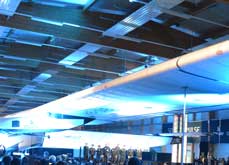
Curtains were up for a visionary project recently that was first mooted in 2010. The second Solar Impulse aircraft, which is to be the first to travel around the world entirely without fuel in 2015, was unveiled recently in Payerne, Switzerland. It features solutions from Germany-based Bayer MaterialScience that make the plane lightweight and energy efficient, including a novel insulating material for the cockpit.
On its historic journey around the world, the plane is to be powered solely by the sun. The energy will be generated by roughly 17,200 solar cells on the wings, which at 72 m have a span equal to that of the largest passenger airliners. Even with this, the entire aircraft weighs 2.3 tonnes.
The new plane is the advancement of a first prototype, which demonstrated in 2010 the feasibility to fly day and night only on solar energy and since then successfully completed numerous flights, most recently a coast-to-coast journey across the US. The second model will undertake a number of test flights this year as well, prior to setting off on its big mission in March 2015.
The aircraft was unveiled to a large audience invited by Bertrand Piccard and André Borschberg, who founded the Solar Impulse project over ten years ago. The two Swiss pioneers want their project to demonstrate the potential of existing technologies for contributing to energy efficiency, renewable energies and new transportation solutions.
"The Solar Impulse initiative is both scientific and innovative. It is also philosophical, by its goal of raising awareness in society about the need to save our planet’s energy resources. Without Bayer and its mission of conducting ‘Science For A Better Life’ this solar airplane would never have been light and efficient enough to be able to fly night and day without fuel," Piccard said.
Bayer MaterialScience was responsible for the complete design of the cockpit shell, using its insulating material Baytherm Microcell. Its insulating performance is said to be 10% greater than the current standard, which is particularly important for the aircraft because it must withstand temperature fluctuations between minus 40 degrees Celsius at night and plus 40 degrees during the day.
Baytherm Microcell is used for the aircraft door, while the rest of the cockpit shell is made of a different type of rigid polyurethane foam, also from Bayer MaterialScience. The company also supplies a polyurethane/carbon fibre composite material for the door locks, and thin sheets of transparent, polycarbonate for the window. Although the cockpit is larger overall than in the first prototype, it is only minimally heavier.
Outside the cockpit, rigid polyurethane foam is used to insulate the batteries. The company also provides the raw materials for the silvery coating covering large portions of the aircraft and the adhesives that hold the textile fabric in place underneath the wings. The company says it can use the "flying laboratory" to further improve its existing products and solutions, test new things and thus come up with new potential applications.
(PRA)

















